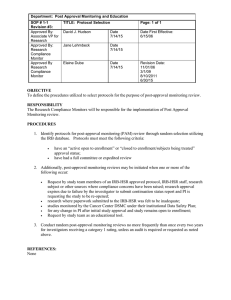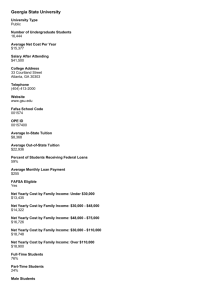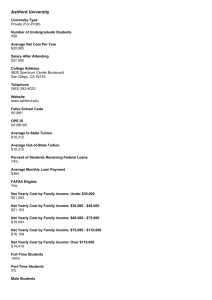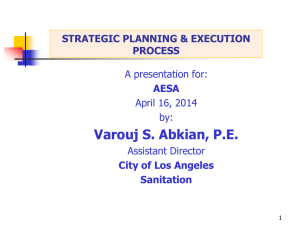A Standard Grant Management Process
advertisement
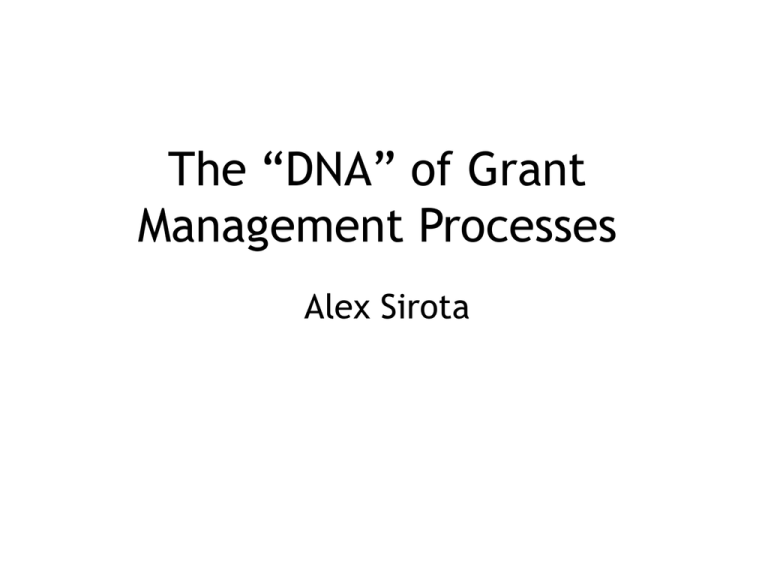
The “DNA” of Grant Management Processes Alex Sirota A Story • Summer Company is yearly entrepreneurship experience for 15-29 year olds. – www.ontario.ca/summercompany • Business Process Reengineering began in 2002 • Now in v9 – – – – – eService Business Consultant wrote requirements with program input Economics and Business Cluster implemented code Yearly project charter < $100,000 Total budget spent - $400,000 over 5+ years Summer Company Registration, Eligibility and Evaluation Network (SCREEN) is result • Reusable internally by other clusters The problem • Fix program mechanics & measure results – – – – – Lead time for applications too short Not enough applications to fill 300-600 grants Incomplete and non-standard applications Identifying “successful completion” Reporting measures of success The solution • • • • • Yearly continual iterations to improve Build Front and Back Office together Workflow built in based on grant best-practices Easy to learn and use Provide access to pre- and post-approval application processes for ALL stakeholders • Rudimentary Reporting and Integration with Finance to Disburse Cheques – https://stage.ontariocanada.com/screen (Front Office) – https://stage.ontariocanada.com/screen_bo (Back Office) Status Quo • All paper applications have been deprecated – SCREEN has processed over 15,000 applications since 2003, over 2000 approved applications. • Privacy Impact Assessment (PIA) completed by OCIPO with 10 recommendations to continue to remove private information from all existing paper-based processes (disbursement requests to Finance) • Organizations have recently approached us to use the code and model – Issues: Liability, timing, support, open-source, making system a generic platform, cost not usually an issue In short… • Success in grant management is *much* more than effective processing and administration • Important to properly address: – – – – – – – – – Privacy Complete applications Provide control to proponents during pre/post-approval Relationship management Measuring financial forecasts/actuals Tracking the “story” of the project Measuring success Reporting longitudinally And Privacy, again Agile Guiding Principles • Individuals and interactions over – processes and tools • Working software over – comprehensive documentation • Customer collaboration over – contract negotiation • Responding to change over – following a plan A proposal… • Approach in incremental steps, implementing only shared, common needs and functionality • Work from a “strawdog” approach, testing a standard logic model • Leverage an “open source” model of development both from a business process and a code perspective – Build an abstraction layer to benefit all who use the system • Build a strong community of practice with process and code as the backbone Benefits of Proposal • Incremental approach will yield quick wins for organizations that can adopt proposed grant model • Creating a shared grant logic model will make it easier for others to install-and-run • Open-source will make it easy for organizations in the BPS to contribute and receive benefits from code library • Learning from each other’s successes and failures in a community of practice centered around the “project” How unique are grant processes? • Is there a shared “DNA” between different grant processes? • Imagine: – An easy to configure, scalable, inexpensive grant management process that is available to anyone in the OPS or the Broader Public Sector. True or False? • We have plenty of time to get this right? – Culture change takes 5+ years, not 1 or 2, consultants are always available to “help” – Government collects and spends money, we are good at collecting, but spending effectively and measuring outcomes? • Technology solutions are the answer? – Appear to solve the mechanics problem (20%) • We know how to measure performance and outcomes? – Program measurement, performance and outcomes are not usually addressed effectively (80%) One “DNA” strand for GM • A logic model: – – – – – – – – – – – Eligibility Check Application Inquiry (aka Part A) Authentication Formal Application (aka Part B) Submission Recommendation Evaluation Approval/Initial Disbursement(s) Project Monitoring Successful/Unsuccessful Completion Project/Outcome Reporting References • Lawrence Lessig “Code is Law” – harvardmagazine.com/2000/01/code-is-law.html • Agile Methodologies – www.agilemanifesto.org and www.agilealliance.org • Independent Blue Ribbon Panel “From Red Tape to Clear Results” – www.brp-gde.ca • Project Streamline report from foundations in US – www.projectstreamline.org • Open Proposal Appraisal http://sourceforge.net/projects/opa • Vista – Veteran’s Administration open source solution, runs Mexico’s health care system TODO • Create mapping of SCREEN modules to Common Process Model/Workflow – Intake, filtering, funding provision, monitoring & closure – Agreement Management, Financial Management, Information Management, Operations, Performance – Information & Referral, Client Advice, Community & Industry Advice, Service Development & Monitoring, Governance, Framework Management, Integrity Management need to be worked out Explore ROI of Build vs Buy • Solutions for grant management are immature, long term cost for support could be a lot larger than you think – customization is always hidden cost • Building your own, deployment on cloud computing systems like Google’s “App Engine”
